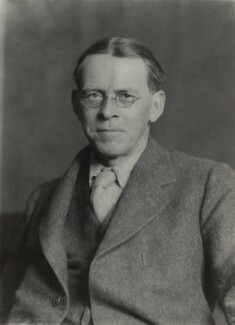Lascelles Abercrombie facts for kids
Quick facts for kids
Lascelles Abercrombie
|
|
|---|---|

Abercrombie in 1937.
|
|
| Born | 9 January 1881 Ashton upon Mersey, Sale, England, United Kingdom of Great Britain and Ireland |
| Died | 27 October 1938 (aged 57) London, England, UK |
| Occupation | Journalist, lecturer |
| Alma mater | Malvern College, Owens College |
Lascelles Abercrombie (born January 9, 1881 – died October 27, 1938) was a British poet and writer. He was also a literary critic, which means he wrote about and judged other people's books. He was known as one of the "Dymock poets". After the First World War, he became a professor of English literature at several universities in England. He mostly wrote about how literature works.
Contents
About Lascelles Abercrombie
Lascelles Abercrombie was born in Ashton upon Mersey, a town near Sale, England. He went to school at Malvern College. Later, he studied at Owens College, Manchester.
Life as a Poet
Before the First World War, Abercrombie lived in a village called Dymock in Gloucestershire. He was part of a group of poets who lived there. This group included famous poets like Robert Frost, Rupert Brooke, and Edward Thomas. They were known as the Dymock poets.
Abercrombie's poems were also part of a collection called "Georgian Poetry". This collection featured many popular poets of that time. Before the war, he made a living by reviewing books. This is also when he started writing his own poetry.
His first book of poems, Interludes and Poems, came out in 1908. He then wrote Mary and the Bramble (1910) and a play called Deborah. Other works included Emblems of Love (1912) and Speculative Dialogues (1913). He also wrote books about how poetry works, like Poetry, Its Music and Meaning (1932).
Becoming a Professor
During the First World War, Lascelles Abercrombie worked as an examiner for military supplies. After the war, he started teaching. He became the first poetry lecturer at the University of Liverpool.
In 1922, he became a Professor of English at the University of Leeds. He was very interested in heroic poetry, which is a long poem about a hero's adventures. In 1929, he moved to the University of London. Then, in 1935, he moved to the famous University of Oxford. There, he became a Fellow at Merton College.
He wrote many books about poetry, such as The Idea of Great Poetry (1925). He also published several books of his own poems and plays. These often explored deep ideas in a dramatic way.
Later Life and Legacy
Lascelles Abercrombie had serious diabetes in his later years. He passed away in London in 1938 when he was 57 years old.
Interestingly, after the Second World War, it was found that his name was on a secret list. This list, called "The Black Book", contained names of British people who would be arrested if the Nazis invaded Britain. This was a mistake, as he had already died.
Abercrombie's Family
Lascelles Abercrombie had a famous brother named Patrick Abercrombie. Patrick was an architect and a well-known town planner.
In 1909, Lascelles married Catherine Gwatkin. They had four children: one daughter and three sons. Two of their sons became quite famous. David Abercrombie became an expert in how sounds are made in speech. Michael Abercrombie became a cell biologist, studying tiny parts of living things. Michael's son, Nicholas Abercrombie, is a sociologist, who studies human society.
His grandson, Jeffrey Cooper, created a helpful list of all his grandfather's writings. A great-grandson, Joe Abercrombie, is also a well-known author today.
The famous children's author Arthur Ransome dedicated his adventure novel Swallowdale to Lascelles' daughter, Elizabeth.
His Poetry and Plays
Abercrombie's poems were often long and written in a style called blank verse. This means the lines don't rhyme but have a regular rhythm. Many of his poems were like plays, with characters speaking.
His works often explored strong feelings, from great joy to deep sadness. His poems used vivid, clear images and often had a strong, rough sound. While some experts admired his work, it was never very popular with everyone.
However, his "Four Short Plays" from 1922 are still noticed today. Especially the play "The Staircase" is liked because its characters and settings feel more real. These plays are often seen as better than the poetic plays written by other poets of his time.
Works by Lascelles Abercrombie
| Title | Year | What it is |
|---|---|---|
| Interludes and Poems | 1908 | A book of poems |
| "Mary and the Bramble" | 1910 | A poem |
| Deborah | A play | |
| Emblems of Love | 1912 | A series of poems |
| Speculative Dialogues | 1913 | A book of prose (regular writing, not poetry) |
| The End of the World | 1914 | A play |
| An Essay Towards a Theory of Art | 1922 | An essay about art |
| The Theory of Poetry | 1924 | An essay about poetry |
| The Idea of Great Poetry | 1925 | An essay about great poetry |
| Poetry, Its Music and Meaning | 1932 | A book about poetry |
| Collected Poems | 1930 | A collection of his poems |
| "The Sale of St. Thomas" | 1930 | A poem |

